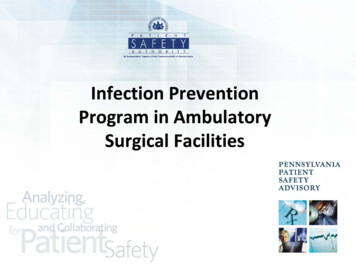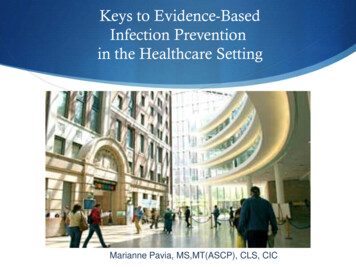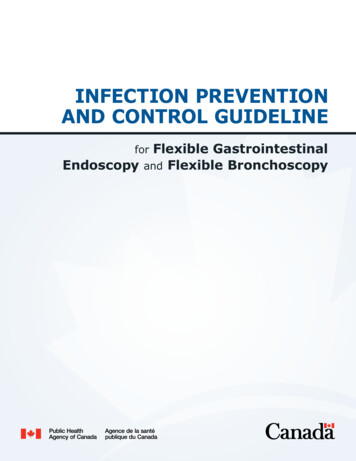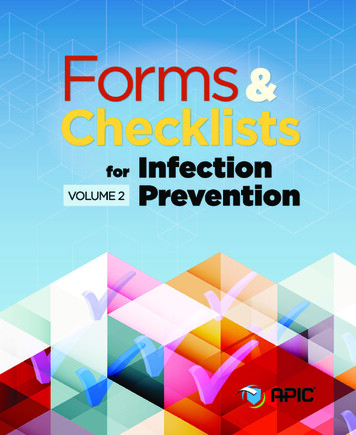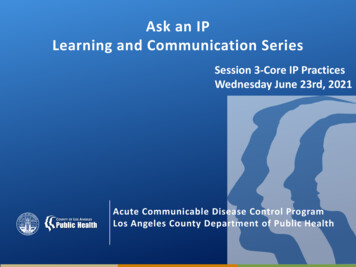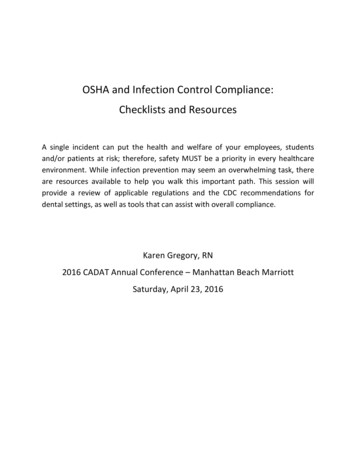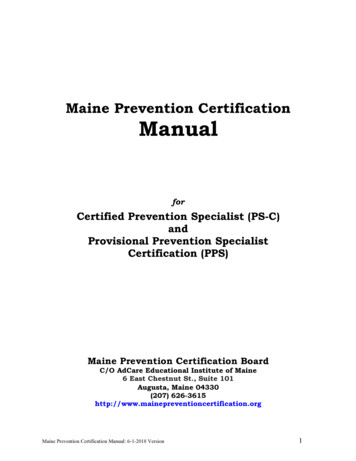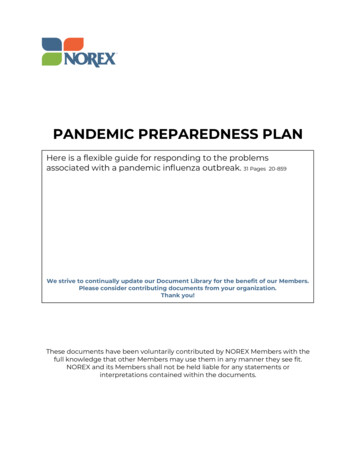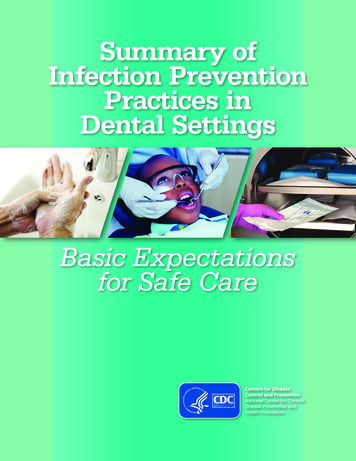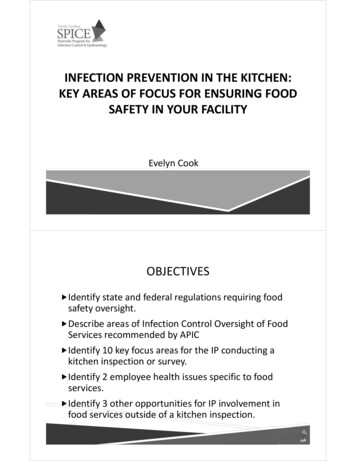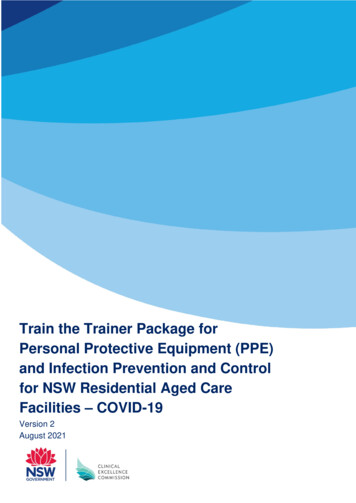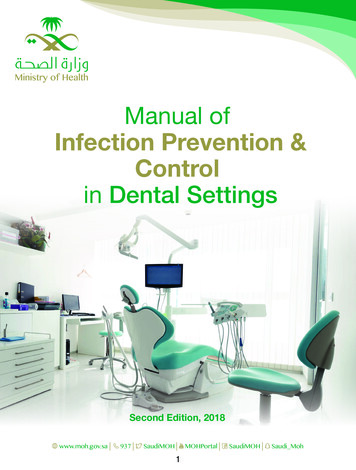
Transcription
Manual ofInfection Prevention &Controlin Dental SettingsSecond Edition, di Moh
2
Message from the General Director,The unique nature of many dental procedures, instrumentation, and patient-care settings requiresspecific strategies directed to prevent the transmission of pathogens among dental healthcareworkers and their patients. In this context the General Directorate of Infection Prevention andcontrol (GDIPC), in collaboration with General Directorate of Dentistry has completed the updatesfor the 2nd edition of the Infection Prevention & Control Manual for Dentals Settings.In the second edition of the Infection Prevention & Control Manual for dental settings, all of theprevious policies were reviewed and edited to reflect updates in infection control practices. Inaddition, this manual aims to address other important requirements in improving and maintainingsafe dental healthcare facilities, hence, new policies on environmental health and aseptictechniques and other aspects were included to expand on the information and guidance that isneeded to implement infection prevention and control strategies in dental healthcare institutions.This manual is providing the most updated and evidence-based recommendations regardingdental infection control and by maintaining high levels of adoption of the current Center for DiseaseControl and Prevention infection control guidelines as well as other relevant guidelines.It is highly important that recommendations mentioned in the manual are strictly adhered to by alldental healthcare personnel in order to prevent the possibility of risk of cross contaminationoccurring in dental clinic, thereby producing a safe environment for both patients and staff.Wishing you all the best.Dr. Khaild Hamdan AlanaziDirector General, General Directorate of Infection Prevention and ControlMinistry of healthRiyadh, Kingdom of Saudi Arabia3
ApprovalNameTitleSupervisor of DentalPrepared ByDr.Abobakr Alawi Al-jifriInfection ControlProgramSupervisor ofDr.Ali Sulamian AlrumikanPreventive DentistryProgramReviewed BySupervisor ofDr.Faiza Abdullah AlfozanProgramsDepartmentGeneral Directorate ofInfection Preventionand ControlGeneral Directorate ofDental ServicesGeneral Directorate ofInfection Preventionand ControlGeneral Directorate ofDr. Khaild Hamdan AlanaziGeneral DirectorInfection Preventionand ControlApproved ByDr.Saud Mohamed OrfoliGeneral DirectorGeneral Directorate ofDental ServicesList of Tables:TableTable TitleNumberTable (1)Table (2)Table (3)Table (4)Categories of glove-associated skin reactionsCategories of Dental Patient-Care Instruments form the infectioncontrol prospectiveCategories of Disinfectants/ Sterilants and Recommended Uses inDentistry.Recommendations for Disinfection of Polysulfide and Silicon RubberImpressions.PageNumber35526598Table (5)Recommendations for Disinfection of Polyether Impressions.98Table (6)Recommendations for Disinfection of Hydrocolloid Impressions.99Table (7)Recommendations for Disinfection of ZOE.99Table (8)Recommendations for Disinfection of Stone Casts and CustomImpression Trays (Acrylic).99Table (9)Disinfection of Dental Prostheses and Appliances.100Table (10)Recommended post exposure prophylaxis (PEP) for exposure to HBV.125Table (11)Recommended post exposure prophylaxis (PEP) for exposure to HIV.1264
List of Figures:FigureFigure TitleNumberPageNumberFigure (1)Hand Rubbing Technique, English.14Figure (2)Hand Rubbing Technique, Arabic.15Figure (3)Hand Rubbing Technique, (Combined Arabic and English).16Figure (4)Hand Washing Technique.17Figure (5)Hand Washing Technique, Arabic.18Figure (6)Hand washing technique, (Combined Arabic and English).19Figure (7)Combined Hand Hygiene Techniques, English.20Figure (8)Surgical Hand Rubbing Technique.21Figure (9)Five moments of hand hygiene, English.22Figure (10)Five moments of hand hygiene, Arabic.23Figure (11)Sequence for putting on personal protective equipment.29Figure (12)How to remove personal protective equipment, example 1.30Figure (13)How to remove personal protective equipment, example 2.31Figure (14)Respiratory Hygiene and Cough Etiquette, English.39Figure (15)Respiratory Hygiene and Cough Etiquette, Arabic.40Figure (16)Example of Needle Recapping Device.43Figure (17)Safety needle with integral retractable sheath.44Figure (18)Self-sheathing anesthetic needles.44Figure (19)Disposable retractable scalpel blade.45Figure (20)Sharps Container.45Figure (21)This shows recapping a needle by hand. Do not do this.46Figure (22)This shows the one-handed scoop technique.46Figure (23)This shows the passing of an exposed needle.47Figure (24)This shows picking up a sharp with a gloved hand.47Figure (25)Sharp instrument was placed on the cassette in an unstableposition.47Figure (26)Examples of clinical contact surfaces.66Figure (27)Examples of housekeeping surfaces.66Figure (28)The Bio-hazard Logo80Figure (29)Radiographic film protected with plastic barrier covers.875
List of policies:Policy TitlePolicy NumberPageNumberStandard PrecautionsGDIPC-IPP-DN-018Hand HygieneGDIPC-IPP-DN-0210Personal Protective EquipmentGDIPC-IPP-DN-0324Contact Dermatitis and Latex HypersensitivityGDIPC-IPP-DN-0432Respiratory Hygiene and Cough EtiquetteGDIPC-IPP-DN-0536Sharps SafetyGDIPC-IPP-DN-0641Safety Injection PracticesGDIPC-IPP-DN-0748Sterilization of Patient Care ItemsGDIPC-IPP-DN-0850Sterilization MonitoringGDIPC-IPP-DN-0953Transporting Contaminated ItemsGDIPC-IPP-DN-1056Storing Sterile ItemsGDIPC-IPP-DN-1158Opening of Instrument PackagesGDIPC-IPP-DN-1259Environmental Surfaces Infection ControlGDIPC-IPP-DN-1360Treatment of Dental Unit WaterlinesGDIPC-IPP-DN-1467Water Quality MonitoringGDIPC-IPP-DN-1571Waste ManagementGDIPC-IPP-DN-1673Management of Extracted TeethGDIPC-IPP-DN-1781Infection Control in Dental RadiographyGDIPC-IPP-DN-1883Infection Control in Dental lab and ProsthodonticsGDIPC-IPP-DN-1988Infection Control in EndodonticsGDIPC-IPP-DN-20101Aseptic TechniquesGDIPC-IPP-DN-21103Single-Use DevicesGDIPC-IPP-DN-22106Dental Handpieces and devices attached to air or waterlinesGDIPC-IPP-DN-23106Oral Surgical ProceduresGDIPC-IPP-DN-24108Clinical AsepsisGDIPC-IPP-DN-25110Tuberculosis Considerations in Dental SettingsGDIPC-IPP-DN-26113Transmission-Based PrecautionsGDIPC-IPP-DN-27114Immunizations for Dental Healthcare PersonnelGDIPC-IPP-DN-28118Management of Occupational ExposuresGDIPC-IPP-DN-29120Patient Screening and EvaluationGDIPC-IPP-DN-30130Infection Control Team In The Dental CenterGDIPC-IPP-DN-311326
Policy title: Standard PrecautionsPolicy Number: GDIPC-IPP-DN-01Effective Date: November 11, 2018Revision Due: November 11 , 20211. Policy Statement:1.1. This policy is a guide for all dental healthcare personnel to ensure full understanding ofapplication of standard precautions in the dental practice.2. Purpose:2.1. To prevent/minimize the risk of infection in dental settings.2.2. To promote awareness for each dental personnel in the importance of standardprecautions.2.3. To provide a framework for the education of dental healthcare personnel in the infectionprevention and control.3. Scope:3.1. This policy applies to all dental healthcare personnel.4. Roles and Responsibilities:4.1. All healthcare workers have responsibility to conform and respect all aspects of thispolicy.4.2. Managers/ department heads have a key responsibility to ensure their departmentfunctions within the parameters of the policy and that staff are trained and assessed inthese issues5. Definitions / Abbreviations:5.1. DHCP: dental healthcare personnel.5.2. Standard Precautions: are the minimum infection prevention practices that apply to allpatient care, regardless of suspected or confirmed infection status of the patient, in anysetting where health care is delivered.5.3. Transmission-based precautions: a set of practices that apply to patients withdocumented or suspected infection or colonization with highly transmissible orepidemiologically important pathogens for which precautions beyond the standardprecautions are needed to interrupt transmission in healthcare settings.6. Procedure:6.1. The standard precautions should be applied to apply to all patient care, regardless ofsuspected or confirmed infection status of the patient, in any setting where health careis delivered.6.2. These practices are designed to both protect DHCP and prevent DHCP from spreadinginfections among patients.6.3. Standard Precautions include:6.3.1.Hand Hygiene: (Refer to policy number GDIPC-IPP-DN-02)6.3.2.Use of personal protective equipment (e.g., gloves, masks, eyewear). (Refer topolicy number GDIPC-IPP-DN-03)6.3.3.Respiratory hygiene/cough etiquette. (Refer to policy number GDIPC-IPP-DN-05)6.3.4.Sharps safety. (Refer to policy number GDIPC-IPP-DN-06).6.3.5.Safe injection practices. (Refer to policy number GDIPC-IPP-DN-07).6.3.6.Sterilization of instruments and devices: (Refer to policy number GDIPC-IPP-DN08).6.3.7.Cleaning and disinfection of environmental surfaces: (Refer to policy numberGDIPC-IPP-DN-13).6.4. Standard precautions should be applied to contact with:7
Policy title: Standard PrecautionsPolicy Number: GDIPC-IPP-DN-01Effective Date: November 11, 2018Revision Due: November 11 , 20216.4.1.Blood; all body fluids, secretions, and excretions (except sweat), regardless ofwhether they contain blood;6.4.2.Non-intact skin;6.4.3.Mucous membranes.6.4.4.Saliva has always been considered a potentially infectious material in dentalinfection control.6.5. Education and training are critical elements of standard precautions, because they helpDHCP make appropriate decisions and comply with recommended practices.6.6. When Standard Precautions alone cannot prevent transmission, they are supplementedwith Transmission-Based Precautions. This second tier of infection prevention is usedwhen patients have diseases that can spread through contact, droplet or airborneroutes (and are always used in addition to Standard Precautions. (Refer to policynumber GDIPC-IPP-DN-27).7. References:7.1. Guidelines for Infection Control in Dental Health-Care Settings, Centers for DiseaseControl and Prevention, 2016.8. Appendices:8.1. None.8
Policy Title: Hand HygienePolicy Number: GDIPC-IPP-DN-02Effective Date: November 11, 2018Revision Due: November 11, 20211. Policy Statement:1.1. This policy is a guide to all dental healthcare personnel to ensure full understanding ofapplication of hand hygiene in dental practice.2. Purpose:2.1. To prevent/minimize the risk of infection in dental settings.2.2. To promote awareness for each dental personnel in the importance of Hand Hygiene.2.3. To provide a framework for the education of dental healthcare personnel in the infectionprevention and control.3. Scope:3.1. This policy applies to all dental healthcare personnel.4. Roles and Responsibilities:4.1. All healthcare workers have responsibility to conform and respect all aspects of thispolicy.4.2. Managers/ department heads have a key responsibility to ensure their departmentfunctions within the parameters of the policy and that staff are trained and assessed inthese issues.5. Definitions / Abbreviations:5.1. Alcohol-based hand rub: an alcohol-containing preparation designed for application to5.2.5.3.5.4.5.5.5.6.5.7.5.8.the hands to reduce the number of viable microorganisms on the hands.Antimicrobial soap: a soap (i.e., detergent) containing an antiseptic agent.Antiseptic: a germicide that is used on skin or living tissue for the purpose of inhibitingor destroying microorganisms.Antiseptic hand rub: the process of applying an antiseptic hand-rub product to allsurfaces of the hands to reduce the number of microorganisms present.Antiseptic hand wash: washing hands with water and soap or detergents containing anantiseptic agent.Hand hygiene: a general term that applies to hand washing, antiseptic hand wash,antiseptic hand rub, and surgical hand antisepsis.Hand washing: washing hands with plain (i.e., non-antimicrobial) soap and water.Surgical hand scrub: an antiseptic-containing preparation that substantially reducesthe number of microorganisms on intact skin; it is broad-spectrum, fast-acting, andpersistent6. Procedure:6.1. Indications for Hand Hygiene:6.1.1. Wash hands with soap and water when visibly dirty or visibly soiled with bloodor other body fluids or after using the toilet.6.1.2. If exposure to potential spore-forming pathogens is strongly suspected orproven, including outbreaks of Clostridium difficile, hand washing with soap andwater is the preferred means.6.1.3. Use an alcohol-based hand-rub as the preferred means for routine handantisepsis in all other clinical situations described in items listed in (6.1.5), if handsare not visibly soiled.6.1.4. If alcohol-based handrub is not obtainable, wash hands with soap and water9
Policy Title: Hand HygienePolicy Number: GDIPC-IPP-DN-02Effective Date: November 11, 2018Revision Due: November 11, 20216.1.5. Perform hand hygiene:6.1.5.1.Before and after touching the patient.6.1.5.2.before handling an invasive device for patient care, regardless ofwhether or not gloves are used6.1.5.3.after contact with body fluids or excretions, mucous membranes, nonintact skin, or wound dressings6.1.5.4.If moving from a contaminated body site to another body site during careof the same patient.6.1.5.5.After contact with inanimate surfaces and objects (including medicalequipment) in the immediate vicinity of the patient.6.1.5.6.After removing sterile or non-sterile gloves.6.1.6. Soap and alcohol-based handrub should not be used concomitantly.6.2. Hand Hygiene Techniques:6.2.1. Hand Hygiene Technique with Alcohol-Based Formulation:A.Duration of the entire procedure: 20-30 secondsB.Apply a palm full of alcohol-based handrub and cover all surfaces of thehands.C.Rub hands palm to palm;D.Right palm over left dorsum with interlaced fingers and vice versa;E.Palm to palm with fingers interlaced;F.Backs of fingers to opposing palms with fingers interlocked;G.Rotational rubbing of left thumb clasped in right palm and vice versa;H.Rotational rubbing, backwards and forwards with clasped fingers ofright hand in left palm and vice versa;I.Once dry, your hands are safe.J.(The technique for handrubbing is illustrated in figures 1&2)6.2.2. Hand Hygiene Technique with Soap and Water:6.2.2.1.Duration of the entire procedure: 40-60 seconds.6.2.2.2.Wet hands with water;6.2.2.3.Apply enough soap to cover all hand surfaces;6.2.2.4.Rub hands palm to palm;6.2.2.5.Right palm over left dorsum with interlaced fingers and vice versa;6.2.2.6.Palm to palm with fingers interlaced;6.2.2.7.Backs of fingers to opposing palms with fingers interlocked;6.2.2.8.Rotational rubbing of left thumb clasped in right palm and vice versa;6.2.2.9.Rotational rubbing, backwards and forwards with clasped fingers ofright hand in left palm and vice versa;6.2.2.10. Rinse hands with water;6.2.2.11. Dry hands thoroughly with a single use towel;6.2.2.12. Use towel to turn off faucet;6.2.2.13. Your hands are now safe.6.2.2.14. (The technique for hand washing is illustrated in figures 3&4).6.3. Recommendations for surgical hand preparation:10
Policy Title: Hand HygienePolicy Number: GDIPC-IPP-DN-02Effective Date: November 11, 2018Revision Due: November 11, 20216.3.1. Remove rings, wrist-watch, and bracelets before beginning surgical handpreparation.6.3.2. Sinks should be designed to reduce the risk of splashes.6.3.3. If hands are visibly soiled, wash hands with plain soap before surgical handpreparation. Remove debris from underneath fingernails using a nail cleaner,preferably under running water.6.3.4. Brushes are not recommended for surgical hand preparation.6.3.5. Surgical hand antisepsis should be performed using either a suitableantimicrobial soap or suitable alcohol-based handrub, preferably with a productensuring sustained activity, before donning sterile gloves.6.3.6. When performing surgical hand antisepsis using an antimicrobial soap, scrubhands and forearms for the length of time recommended by the manufacturer,typically 2–5 minutes. Long scrub times (e.g. 10 minutes) are not necessary.6.3.7. When using an alcohol-based surgical handrub product with sustained activity,follow the manufacturer’s instructions for application times. Apply the product todry hands only. Do not combine surgical hand scrub and surgical handrub withalcohol-based products sequentially.6.3.8. When using an alcohol-based handrub, use sufficient product to keep handsand forearms wet with the handrub throughout the surgical hand preparationprocedure. (The technique for surgical hand preparation using alcohol-basedhandrubs is illustrated in Figures 6 & 7.)6.3.9. After application of the alcohol-based handrub as recommended, allow handsand forearms to dry thoroughly before donning sterile gloves6.4. Selection and handling of hand hygiene agents:6.4.1. Provide HCWs with efficacious hand hygiene products that have low irritancypotential.6.4.2. To maximize acceptance of hand hygiene products by HCWs, ask for their inputregarding the skin tolerance, feel, and fragrance of any products underconsideration.6.4.3. When selecting hand hygiene products:6.4.3.1.Determine any known interaction between products used to cleanhands, skin care products, and the types of glove used in the institution.6.4.3.2.Ask for information from manufacturers about the risk of productcontamination.6.4.3.3.Ensure that dispensers are accessible at the point of care.6.4.3.4.Ensure that dispensers function adequately and reliably and deliver anappropriate volume of the product.6.4.3.5.Ensure that the dispenser system for alcohol-based handrubs isapproved for flammable materials.6.4.3.6.Ask for and evaluate information from manufacturers regarding anyeffect that hand lotions, creams, or alcohol-based handrubs may have on theeffects of antimicrobial soaps being used in the institution.11
Policy Title: Hand HygienePolicy Number: GDIPC-IPP-DN-02Effective Date: November 11, 2018Revision Due: November 11, 20216.4.3.7.Cost comparisons should only be made for products that meetrequirements for efficacy, skin tolerance, and acceptability.6.4.3.8.Do not add soap or alcohol-based formulations to a partially empty soapdispenser.6.5. My (5) moments of hand hygiene:6.5.1. Moment (1): Before touching a patient:6.5.1.1.When?A.Clean your hands before touching a patient when approaching him/her.6.5.1.2.Why?A.To protect the patient against harmful germs carried on your hands.6.5.2. Moment (2): Before clean/ aseptic procedure:6.5.2.1.When?A.Clean your hands immediately before performing a clean/asepticprocedure.6.5.2.2.Why?A.To protect the patient against harmful germs, including the patient'sown, from entering his/her body.6.5.3. Moment (3): After body fluid exposure risk:6.5.3.1.When?A.Clean your hands immediately after an exposure risk to body fluids (andafter glove removal).6.5.3.2.Why?A.To protect yourself and the health-care environment from harmfulpatient germs.6.5.4. Moment (4): After touching a patient:6.5.4.1.When?A.Clean your hands after touching a patient and her/his immediatesurroundings, when leaving the patient’s side.6.5.4.2.Why?A.To protect yourself and the health-care environment from harmfulpatient germs.6.5.5. Moment (5): After touching patient surroundings:6.5.5.1.When?A.Clean your hands after touching any object or furniture in the patient’simmediate surroundings, when leaving – even if the patient has notbeen touched.6.5.5.2.Why?A.To protect yourself and the health-care environment from harmfulpatient germs.6.6. Storage and dispensing of hand-care products:6.6.1. Soap should not be added to a partially empty dispenser, because the practiceof topping off might lead to contamination. Signs of contamination include theproduct becoming discolored or cloudy, or developing an unusual odor.12
Policy Title: Hand HygienePolicy Number: GDIPC-IPP-DN-02Effective Date: November 11, 2018Revision Due: November 11, 20216.6.2. Always store and dispense products according to the manufacturer's directions.6.7. Fingernails and jewelry:6.7.1. Do not wear artificial fingernails or extenders when having direct contact withpatients.6.7.2. Keep natural nails short (tips less than 0.5 cm long or approximately ¼ inch).7. References:7.1. WHO guidelines on hand hygiene in health care. (2009)8. Appendices:8.1. Figure (1): Hand Rubbing Technique, English.8.2. Figure (2): Hand Rubbing Technique, Arabic.8.3. Figure (3): Hand Rubbing Technique, (Combined Arabic and English).8.4. Figure (4): Hand Washing Technique.8.5. Figure (5): Hand Washing Technique, Arabic.8.6. Figure (6): Hand washing technique, (Combined Arabic and English).8.7. Figure (7): Combined Hand Hygiene Techniques, English.8.8. Figure (8): Surgical Hand Rubbing Technique.8.9. Figure (9): five moments of hand hygiene, English.8.10.Figure (10): five moments of hand hygiene, Arabic.13
Policy Title: Hand HygienePolicy Number: GDIPC-IPP-DN-02Effective Date: November 11, 2018Revision Due: November 11, 2021Figure (1) Hand Rub Technique14
Policy Title: Hand HygienePolicy Number: GDIPC-IPP-DN-02Effective Date: November 11, 2018Revision Due: November 11, 2021Figure (2) Hand Rub Technique, Arabic15
Policy Title: Hand HygienePolicy Number: GDIPC-IPP-DN-02Effective Date: November 11, 2018Revision Due: November 11, 2021Figure (3): Hand rubbing technique (combined Arabic and English)16
Policy Title: Hand HygienePolicy Number: GDIPC-IPP-DN-02Effective Date: November 11, 2018Revision Due: November 11, 2021Figure (4): Hand Washing Technique, English.17
Policy Title: Hand HygienePolicy Number: GDIPC-IPP-DN-02Effective Date: November 11, 2018Revision Due: November 11, 2021Figure (5): Hand Washing Technique, Arabic.18
Policy Title: Hand HygienePolicy Number: GDIPC-IPP-DN-02Effective Date: November 11, 2018Revision Due: November 11, 2021Figure (6): Hand Washing Technique, (Combined Arabic and English).19
Policy Title: Hand HygienePolicy Number: GDIPC-IPP-DN-02Effective Date: November 11, 2018Revision Due: November 11, 2021Figure (7): Combined Hand Hygiene Technique, English.20
Policy Title: Hand HygienePolicy Number: GDIPC-IPP-DN-02Effective Date: November 11, 2018Revision Due: November 11, 2021Figure (8): Combined Hand Hygiene Technique, Arabic.21
Policy Title: Hand HygienePolicy Number: GDIPC-IPP-DN-02Effective Date: November 11, 2018Revision Due: November 11, 2021Figure (9): Five Moments of Hand Hygiene, English.22
Policy Title: Hand HygienePolicy Number: GDIPC-IPP-DN-02Effective Date: November 11, 2018Revision Due: November 11, 2021Figure (10): Five Moments of Hand Hygiene, Arabic.23
Policy Title: Personal Protective EquipmentPolicy Number: GDIPC-IPP-DN-03Effective Date: November 11, 2018Revision Due: November 11, 20211. Policy Statement:1.1. This policy is a guide for all dental healthcare personnel to ensure full understanding onthe best practice of use of personal protective equipment in dental practice.2. Purpose:2.1. To prevent/minimize the risk of infection in dental settings.2.2. To promote awareness for each dental personnel in the importance of PersonalProtective Equipment (PPE).2.3. To provide a framework for education of dental healthcare personnel in the PersonalProtective Equipment (PPE).3. Scope:3.1. This policy applies to all dental healthcare personnel.4. Roles and Responsibilities:4.1. All healthcare workers have responsibility to conform and respect all aspects of thispolicy.4.2. Managers/ department heads have a key responsibility to ensure their departmentfunctions within the parameters of the policy and the staff are trained and assessed inthese issues.5. Definitions / Abbreviations:5.1. Personal Protective Equipment (PPE): specialized clothing or equipment worn by anemployee for protection against a hazard (e.g., gloves, masks, protective eyewear, andgowns).5.2. DHCP: Dental Health Care Personnel.6. Procedure:6.1. Use of PPE:6.1.1.Gloves:6.1.1.1.Wear gloves when there is potential contact with blood, body fluids,mucous membranes, non-intact skin or contaminated equipment.6.1.1.2.These are the most important do’s and don'ts of glove use:A.Wear gloves that fit appropriately (select gloves according to hand size).B.Do not wear the same pair of gloves for the care of more than onepatient.C.Do not wash gloves for the purpose of reuse.D.Perform hand hygiene before and immediately after removing gloves.E.Work from “clean to dirty”.F.Limit opportunities for “touch contamination” to protect yourself,others, and the environment.G.Do not touch your face or adjust PPE with contaminated gloves.H.Do not touch environmental surfaces except as necessary duringpatient care.6.1.1.3.Change gloves:A.During use if torn and when heavily soiled (even during use on the samepatient)B.After use on each patient.C.Discard in appropriate receptacle.D.Never wash or reuse disposable gloves.24
Policy Title: Personal Protective EquipmentPolicy Number: GDIPC-IPP-DN-03Effective Date: November 11, 2018Revision Due: November 11, 20216.1.2.Gowns:6.1.2.1.Wear a gown to protect skin and clothing during procedures or activitieswhere contact with blood or body fluids is anticipated.6.1.2.2.Do not wear the same gown for the care of more than one patient.6.1.2.3.Remove gown and perform hand hygiene before leaving the patient’senvironment (e.g., exam room).6.1.3.Facemasks (Procedure or Surgical Masks):6.1.3.1.Wear a facemask when there is potential contact with respiratorysecretions and sprays of blood or body fluids (as defined in StandardPrecautions and/or Droplet Precautions).6.1.3.2.Masks should fully cover the nose and mouth and prevent fluidpenetration. Masks should fit snuggly over the nose and mouth. For thisreason, masks that have a flexible nose-piece and can be secured to the headwith string ties or elastic are preferable.6.1.4.Goggles, Face Shields:6.1.4.1.Wear eye protection for potential splash or spray of blood, respiratorysecretions, or other body fluids.6.1.4.2.Personal eyeglasses and contact lenses are not considered adequateeye protection6.1.4.3.Goggles should fit snuggly over and around the eyes or personalprescription lenses.6.1.4.4.Goggles with anti-fog features will help maintain clarity of vision.6.1.4.5.When skin protection, in addition to mouth, nose, and eye protection, isneeded or desired, a face shield can be used as a substitute to wearing amask or goggles. The face shield should cover the forehead, extend belowthe chin, and wrap around the side of the face.6.1.5.Respirators:6.1.5.1.Wear N95-or higher respirators for potential exposure to infectiousagents transmitted via the airborne route (e.g., tuberculosis).6.1.5.2.All healthcare personnel that use N95-or higher respirator should be fittested every (2) years according to MOH requirements.6.1.6.Head and Shoe Covers:6.1.6.1.Head and shoe covers are less frequently used types of PPE, but shouldbe considered if contamination is likely.6.1.6.2.It’s not mandated the use of shoe and head covers in dentistry.6.1.6.3.DHCP may want to consider using shoe covers when contamination offootwear is anticipated, such as during surgical procedures where unusuallyheavy bleeding may be anticipated (e.g., maxillofacial reconstructive surgeryand trauma surgery).6.1.6.4.Head covers are optional but may be useful in decreasing contaminationof DHCP during ultrasonic scaling, surgical procedures using rotary orultrasonic instrumentation, and manual decontamination of dentalinstruments, where spraying and spattering of blood and OPIM may begenerated. Head covers also provide maximum protection to patients duringsurgical procedures.25
Policy Title: Personal Protective EquipmentPolicy Number: GDIPC-IPP-DN-03Effective Date: November 11, 2018Revision Due: November 11, 20216.1.7.Recommendations for Donning PPE:6.1.7.1.Always perform hand hygiene before donning PPE.6.1.7.2.Sequence of donning PPE (figure 8):A.The gown should be donned first.B.The mask or respirator should be put on next and properly adjusted tofit; remember to fit check the respirator.C.The goggles or face shield should be donned next.D.The gloves are donned last.E.Keep in mind, the combination of PPE used, and therefore the sequencefor donning, will be determined by the precautions that need to betaken.6.1.7.3.To don a gown:A.First select the appropriate type for the task and the right size for you.B.The opening of the gown should be in the back; secure the gown at theneck and waist.C.If the gown is too small to fully cover your torso, use two gowns.D.Put on the first gown with the opening in front and the second gownover the first with the opening in the back.6.1.7.4.To don a mask:A.If the mask has ties:1)Place the mask over your mouth, nose and chin.2)Fit the flexible nose piece to the form of your nose bridge.3)Tie the upper set at the back of your head and the lower set at thebase of your neck.B.If a mask has elastic head bands:1)Separate the two bands, hold the mask in one hand and the bandsin the other.2)Place and hold the mask over your nose, mouth, and chin.3)Then stretch the bands over your head and secure themcomfortably; one band on the upper back of your head, the otherbelow the ears at the base of the neck.4)Adjust the mask to fit. Remember, you don’t want to be touchingit during use so take the few seconds needed to make sure it issecure on your head and fits snuggly around your face so thereare no gaps.6.1.7.5.To don a respirator:A.The technique for donning a particulate respirator, such as an N95, issimilar to putting on a pre-formed mask with elastic headbands.B.Key differences, however, are:1)The need to first select a respirator for which you have been fittested.2)Fit checking the device, as you have been instructed, beforeentering an area where there may be airborne infectious disease.3)Be sure to follow the manufacturer’s instructions for donning thedevice.26
Policy Title: Personal Protective EquipmentPolicy Number
Figure (11) Sequence for putting on personal protective equipment. 29 Figure (12) How to remove personal protective equipment, example 1. 30 Figure (13) How to remove personal protective equipment, example 2. 31 Figure (14) Respiratory Hygiene and Cough Etiquette, English. 39 Figure (15) Respiratory Hygiene and Cough Etiquette, Arabic. 40
